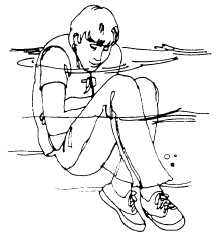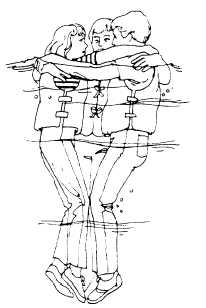| |
and the third leading cause of accidental deaths in the
United States. From 1987 to 1992, 42 percent of all
Navy people killed in recreational mishaps died from
drowning. You can prevent drowning by knowing some
common water-safety tips.
Swimming
About 45 percent of all drownings involve people
falling in the water while walking on piers and bridges
or fishing from boats. Many victims were poor
swimmers who lacked basic water skills.
If you are going to spend time near the water, you
should know how to swim. Swimming is your best
defense against drowning. You should know how to
swim even if you never expect to go in the water. You
may someday have the opportunity to save a drowning
person’s life.
Always swim with a friend. The buddy system saves
lives. Swim only in designated areas. Undesignated
swimming areas may have hidden hazards that can kill
you.
Teach your children how to swim. Drowning is the
second leading cause of accidental deaths in children.
NEVER leave a child alone near a swimming pool or
swimming area. Many parents think they can hear their
child fall into a pool. They are wrong. Drowning is a
silent killer. There is usually no loud splash or cry for
help because the first gasp for air fills a child’s lungs
with water, blocking all sound. Child-proof your pool,
Install a double layer of protection around your pool.
Build a fence at fence five feet high around the pool with
a self-closing, self-latching gate. Make sure the latch is
out of children’s reach. You also can buy an electronic
sensor that floats in the pool and sounds an alarm if
something disturbs the water.
Beware of cold water. Chances of survival in
50-degree water are only 50-50 if you are exposed for
50 minutes. If you arc alone, usc the heat escape
lessening position (HELP). To do that, huddle to
conserve heat by crossing your arms and feet and pulling
your knees up (fig. 11-1). You can die from
hypothermia, even if you fall into water as warm as 70
degrees, if you stay immersed long enough. If you have
several people in the water, huddle together in a circle
(fig. 11-2). For either of these techniques to be effective,
you must be wearing an approved personal flotation
device.
Do not jump or dive into water that may be so cold
it will numb your body. Instead, ease into the water
Figure 11-1.—Heat escape lessening position (HELP).
Figure 11-2.—Huddle position
gradually. Cold water exhausts a swimmer faster than
warm water. Do not swim long distances in cold water.
Cold or tired muscles are susceptible to cramps. To
overcome a cramp, draw your knees toward your chest
and massage your cramped foot or leg while moving it.
You should be in a “face forward” float position while
doing that.
Know and consider your swimming limitations. Do
not swim when you are tired, overheated, or chilled. If
you find yourself fatigued, you can find temporary relief
by floating, treading water on your back, or varying the
style of swimming. If you find yourself in trouble,
11-4
|


